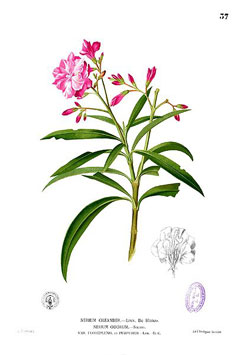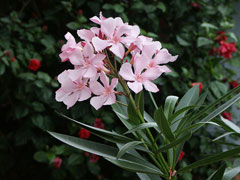 |
|
|
 |
| http://commons.wikimedia.org/wiki/User:Ian_Fieggen |
Translate this page:
Summary
Bloom Color: Orange, Pink, Red, White, Yellow. Main Bloom Time: Early summer, Early fall, Early spring, Early winter, Late summer, Late fall, Late spring, Late winter, Mid summer, Mid fall, Mid spring, Mid winter. Form: Rounded, Vase.
Physical Characteristics

 Nerium oleander is an evergreen Shrub growing to 4 m (13ft) by 4 m (13ft) at a fast rate.
Nerium oleander is an evergreen Shrub growing to 4 m (13ft) by 4 m (13ft) at a fast rate.
See above for USDA hardiness. It is hardy to UK zone 8. It is in leaf all year, in flower from June to October. The species is hermaphrodite (has both male and female organs).
Suitable for: medium (loamy) and heavy (clay) soils, prefers well-drained soil and can grow in heavy clay soil. Suitable pH: mildly acid, neutral and basic (mildly alkaline) soils. It cannot grow in the shade. It prefers dry or moist soil and can tolerate drought. The plant can tolerate maritime exposure.
UK Hardiness Map
US Hardiness Map
Synonyms
N. indica. N. odorum.
Plant Habitats
Woodland Garden Sunny Edge; Hedge;
Edible Uses
References More on Edible Uses
Medicinal Uses
Plants For A Future can not take any responsibility for any adverse effects from the use of plants. Always seek advice from a professional before using a plant medicinally.
Cancer Cardiotonic Diaphoretic Diuretic Emetic Expectorant Leprosy Parasiticide
Resolvent Skin Sternutatory
The leaves and the flowers are cardiotonic, diaphoretic, diuretic, emetic, expectorant and sternutatory[7, 147, 218]. A decoction of the leaves has been applied externally in the treatment of scabies[7], and to reduce swellings[240]. This is a very poisonous plant, containing a powerful cardiac toxin[240], and should only be used with extreme caution[7, 147]. The root is powerfully resolvent. Because of its poisonous nature it is only used externally. It is beaten into a paste with water and applied to chancres and ulcers on the penis[240]. An oil prepared from the root bark is used in the treatment of leprosy and skin diseases of a scaly nature[240]. The whole plant is said to have anticancer properties[218].
References More on Medicinal Uses
The Bookshop: Edible Plant Books
Our Latest books on Perennial Plants For Food Forests and Permaculture Gardens in paperback or digital formats.

Edible Tropical Plants
Food Forest Plants for Hotter Conditions: 250+ Plants For Tropical Food Forests & Permaculture Gardens.
More

Edible Temperate Plants
Plants for Your Food Forest: 500 Plants for Temperate Food Forests & Permaculture Gardens.
More

More Books
PFAF have eight books available in paperback and digital formats. Browse the shop for more information.
Shop Now
Other Uses
Dye Hedge Hedge Insecticide Latex Parasiticide Soil stabilization
The plant is used as a rat poison[46], a parasiticide[7] and an insecticide[100]. The pounded leaves and bark are used as an insecticide[272]. A green dye is obtained from the flowers[168]. The plant is commonly used for informal hedging in the Mediterranean[89, 200], though it is too tender for this use in Britain[K]. The leaves contain small amounts of latex that can be used to make rubber[227], though the amount is too small for commercial utilization[K]. The plants have an extensive root system and are often used to stabilize soil in warmer areas[148].
Special Uses
Food Forest Hedge Hedge Scented Plants
References More on Other Uses
Cultivation details
Landscape Uses:Border, Container, Foundation, Hedge, Massing, Screen, Standard, Seashore, Specimen, Street tree. Prefers a heavy soil[49]. Prefers a light soil according to another report[202]. Requires a position in full sun[49, 184]. Prefers a fertile well-drained soil[200]. Lime tolerant[200, 202]. Plants are very tolerant of heat and also of drought once they are established[166]. Grows well in maritime gardens, tolerating salt-laden winds[200]. This species is not very hardy in Britain, though plants tolerate temperatures down to -5°c and short periods of temperatures down to -10°c[184, 200, 260]. A popular greenhouse pot plant that can be grown outdoors in the summer, it can be grown outdoors all year round in the milder areas such as Cornwall[1, 260]. A very ornamental plant[1], there are many named varieties[200, 260]. Plants are shy to flower when grown outdoors[49, 59]. The flowers have a soft sweet perfume[245]. Special Features:
Not North American native, All or parts of this plant are poisonous, Fragrant flowers, Blooms are very showy. In garden design, as well as the above-ground architecture of a plant, root structure considerations help in choosing plants that work together for their optimal soil requirements including nutrients and water. The root pattern is branching: a heart root, dividing from the crown into several primary roots going down and out [2-1].
References Carbon Farming Information and Carbon Sequestration Information
Temperature Converter
Type a value in the Celsius field to convert the value to Fahrenheit:
Fahrenheit:
The PFAF Bookshop
Plants For A Future have a number of books available in paperback and digital form. Book titles include Edible Plants, Edible Perennials, Edible Trees,Edible Shrubs, Woodland Gardening, and Temperate Food Forest Plants. Our new book is Food Forest Plants For Hotter Conditions (Tropical and Sub-Tropical).
Shop Now
Plant Propagation
Seed - sow spring in a greenhouse[113]. Do not use seed from pods infected with the bacterial disease 'oleander knot'[113]. Prick out the seedlings into individual pots when they are large enough to handle and grow them on in the greenhouse for at least their first winter before planting them out in early summer. Cuttings of half-ripe side shoots, August/September in a frame. Good percentage[78]. Cuttings of mature leading shoots[1].
Other Names
If available other names are mentioned here
Native Range
TEMPERATE ASIA: United Arab Emirates, Oman, Afghanistan, Cyprus, Iran, Iraq, Israel, Jordan, Lebanon, Syria, Turkey, China (Yunnan Sheng) TROPICAL ASIA: India (Jammu and Kashmir, Punjab), Nepal, Pakistan EUROPE: Albania, Greece (incl. Crete & e. Aegean Islands), Croatia, Italy (incl. Sardinia, Sicily), Malta, Spain (incl. Baleares), France (incl. Corsica), Portugal AFRICA: Algeria, Libya, Morocco, Tunisia, Niger
Weed Potential
Right plant wrong place. We are currently updating this section.
Please note that a plant may be invasive in one area but may not in your area so it's worth checking.
Conservation Status
IUCN Red List of Threatened Plants Status :

Growth: S = slow M = medium F = fast. Soil: L = light (sandy) M = medium H = heavy (clay). pH: A = acid N = neutral B = basic (alkaline). Shade: F = full shade S = semi-shade N = no shade. Moisture: D = dry M = Moist We = wet Wa = water.
Now available:
Food Forest Plants for Mediterranean Conditions
350+ Perennial Plants For Mediterranean and Drier Food Forests and Permaculture Gardens.
[Paperback and eBook]
This is the third in Plants For A Future's series of plant guides for food forests tailored to
specific climate zones. Following volumes on temperate and tropical ecosystems, this book focuses
on species suited to Mediterranean conditions—regions with hot, dry summers and cool, wet winters,
often facing the added challenge of climate change.
Read More
Expert comment
Author
L.
Botanical References
50200
Links / References
For a list of references used on this page please go here
Readers comment